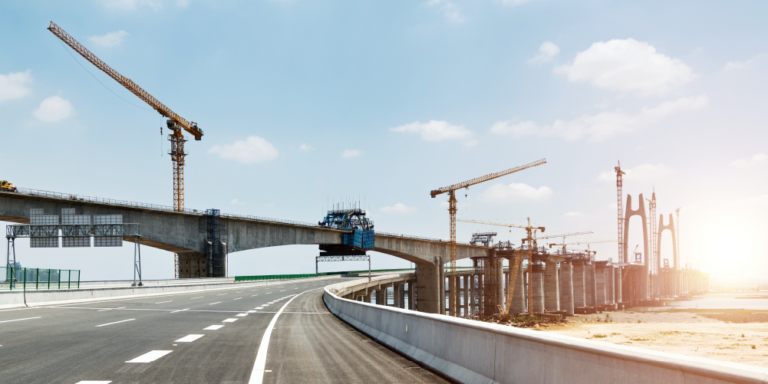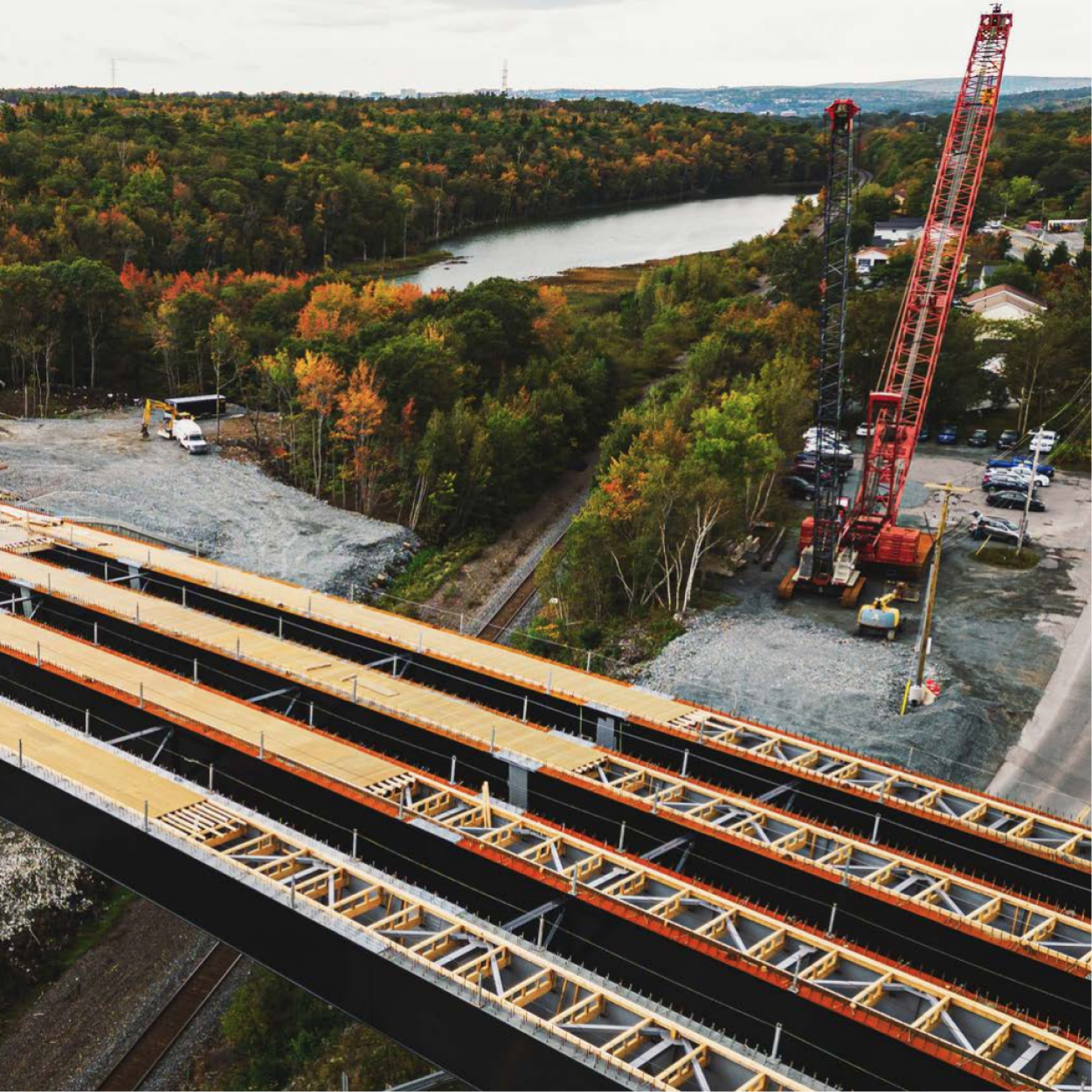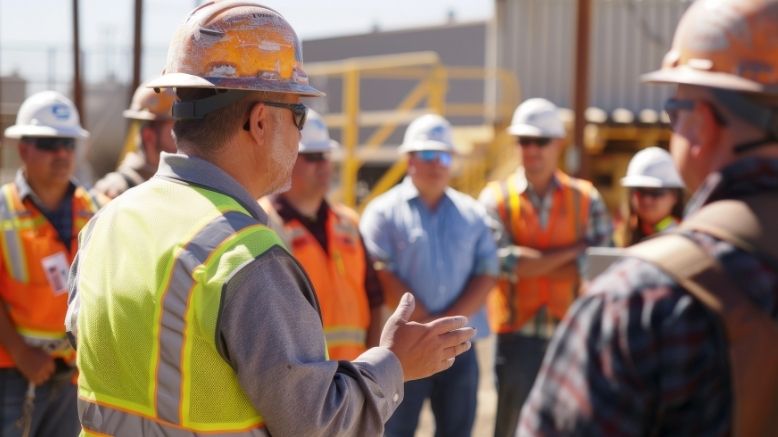— 10 min read
Infrastructure Construction: Laying Foundations for the Future


Last Updated Aug 7, 2025

Sammy Evans
Senior Strategic Product Consultant
Sammy Evans is a Senior Strategic Product Consultant at Procore. She has more than a decade of experience in the construction industry, working as a project engineer for McGeorge Contracting Co. and senior project engineer and project manager at Kitchell. Evans holds a Bachelor of Science in Mining Engineering from Colorado School of Mines. She is based in Phoenix, Arizona.

Trey Strange
Contributing Writer
27 articles
Trey Strange is a Peabody and Emmy-Award winning writer and producer based in Brooklyn, NY. Throughout his career, Trey has worked for the Huffington Post, Houston Chronicle, Out Magazine, Brooklyn Eagle, CNBC, INTO, and New York Magazine's Bedford + Bowery. He received his Masters in Journalism and Middle East studies from New York University, and Bachelors in the same subjects from the University of Houston.
Last Updated Aug 7, 2025

Infrastructure allows our society to physically function. It includes all the different systems a community relies on to meet their needs, from roadways and water to communications and waste management. Because of these facilities' widespread and near-constant use, they experience high levels of wear-and-tear compared to other types of construction projects. As a result, the materials and building methods used in infrastructure work are highly engineered for durability.
With the population in the U.S. and abroad expected to rise through the rest of the century, infrastructure projects can be as financially reliable as they are necessary to the world — even if they do have unique challenges.
This article explores how infrastructure projects happen, what makes them different from other types of construction, and how to best prepare for taking on an infrastructure job.
Table of contents
Types of Infrastructure Projects
Since there are many kinds of infrastructure jobs, and every construction job differs from the last, there's no universal way to characterize each one.
Generally, infrastructure construction typically involves work that is large in both scale and budget, working with highly engineered and specialized systems, often on horizontal job sites that are subject to both the climate and traffic from the community. They also tend to have long payment reviews, and timelines that can wreck a contractor's cash flow.
The most obviously identifiable form of infrastructure is something many of us drive over everyday: roads. But there are many more essential physical structures people need to live — even in remote places. The following lists several types that a contractor may find work on, but it’s not an exhaustive list by any means.
Transportation
The U.S. alone has more than 4 million miles of roads open to the public—about 160,000 of which make up the federal highway system. For a contractor looking for work in transportation construction, this is nowhere near the end of the road.
Read more: What Sets Road Work Construction Apart
Cities might contract construction crews to build or update bridges, as well as other pathways for types of transportation — bike lanes, speed bumps, crossways, sidewalks and even subway systems or other methods of public transportation. Design and technical specifications for these projects are likely to be regulated by the corresponding local and federal departments of transportation in addition to the building department.
A general contractor (GC) in transportation construction needs to be mindful of how to navigate soil mechanics and other environmental factors, especially on roads to ensure durability and keep people safe. It may be necessary to work with asphalt and concrete, which are heavily regulated for environmental concerns, drainage and runoff, and are engineered for winter freezes, but they involve other climate considerations, too.
For example, concrete has about 90 minutes to travel from plant to placement before it is out of specification.
Additionally, it’s important to store and cool concrete properly to avoid falling behind on this scope of work. Also, GCs on road projects often work under unit price contracts, meaning there are specific prices for each foot of pipe or culver placed, for example, or each cubic yard of dirt moved, or foot of striping.
Lastly, some major transportation projects, like a highway expansion or the building of a subway system, might be so large in scale and on such a long timeline there may be a multi-year master plan for their delivery, such as in the case of the Houston light rail, which has opened in 2004 but continues to be constructed in intervals. A project at this scale may be built by several different contractors working years apart from each other with different equipment and technology.
Top Civil & Infrastructure Trends
Discover insights from over 450 civil and infrastructure professionals on industry trends, challenges, business drivers, and success recommendations.

Water and Waste Systems
Water systems are much more complex today than they were 20 or 30 years ago. Larger main underground pipes carry water to and from the source, to treatment centers and storage facilities like water towers, or canals for water conveyance, all of which may need repairs and updating.
A GC should also be prepared to comply with regulations set by the U.S. Corps of Engineers, which has jurisdiction over water supplies designated as waters of the U.S. In order to install safe, functioning systems, they should also understand water flow mechanics, how erosion is controlled and reduced, and the flood risk to the system they’re working on.
It should come as no surprise that the fundamental chemical compound of almost all known life forms is heavily regulated by the EPA and the federal government, which signed the extensive Clean Water Act in 1972, but there may also be state-level regulations. One way a wastewater plant might need a larger-scale renovation is to raise its capacity. Austin, Texas, for example, recently poured about $284 million into the Walnut Creek Wastewater Treatment Plant to increase its capacity from 75 million gallons per day (MGD) to 100 MGD.
Communications
Communications infrastructure includes telephone and signal towers, wires, cables, antennas and satellites. Recent rollouts of fiber optic cables and 5G wireless internet in many cities are different types of communications infrastructure jobs contractors may bid for.
While an ideal infrastructure project is designed to last and serve a lot of people, communications technology in particular changes quickly. Owners and project stakeholders should keep the future-proofing in mind for these types of projects, and ensure sure that it’s possible to switch out older tech with its newer counterparts later on in the process.
Airports
Construction projects at airports can include building terminals, air traffic control towers, aprons, hangers retail spaces as well as re-paving runways and taxiways. Like most infrastructure projects, major airports are generally publicly owned, but privately operated. Public-private partnerships permit government agencies to utilize private funds for these large-scale projects that can take several years to complete.
Due to the level of security clearance needed to access certain areas of an airport, contractors should be strategic in scheduling out subcontractors and ensuring that they have an accurate headcount of workers entering the jobsite each day.
Additionally, scheduling during airport downtimes to prevent disrupting the regular flow of work in an airport should also be considered. Terminals, gates or other sections of the airport may require closing for certain scopes of work and limited to after hours.
Schools, Hospitals & Government Buildings
Sometimes called “social infrastructure,” buildings that are necessary to essential functions of society—like education, governance, or healthcare—are also considered infrastructure, and since public-use buildings tend to be older, they often need renovation or repair.
Job order contracting, or JOC, arrangements allow for contractors to complete work on several smaller-scale projects under one bid. Contractors should ensure they have the labor bandwidth and accurate pricing for materials and labor, as JOC agreements may span several years with projects happening simultaneously with others.
Moving from Commercial to Civil Construction
Depending on the type of project and funding, the construction bid processes can either be hard-bid or qualifications-based. Generally, hard bids are required for government-funded projects. Understanding the differences between commercial and civil projects can help a contractor make the leap into this field.
Stay updated on what’s happening in construction.
Subscribe to Blueprint, Procore’s free construction newsletter, to get content from industry experts delivered straight to your inbox.

5 Keys to Success for Contractors & Planning Agencies
Obviously, what’s considered infrastructure is so expansive that there’s no one-size-fits-all solution to any of its challenges. Still, there are a few things to keep in mind about what to expect.
1. Stay diligent.
A lot of times, an infrastructure contractor is building in places with a lot of uncertainty. For example, a general contractor might be building a new road where there’s very little data about the geography of the existing conditions they’re digging into. A good way to have a competitive bid for this kind of project is to conduct several test holes, so that the contractor can gather as much information as they can about the conditions of the jobsite.
Another important consideration is materials. Sometimes a clause in the contract may require buying American-made materials, especially when it comes to getting steel for bridges. Additionally, scheduling and coordinating the acquisition and delivery of these materials is vital.
Also, each state typically has a spec book, like this one from Arkansas’s Department of Transportation, with all the rules that must be followed to work on their transportation infrastructure. Learning as much as possible from these will not only make the bid process easier for a general contractor—it’ll also make the work go smoother.
2. Be safe and community-minded.
Much of infrastructure work—like laying roads or fixing pipes in the ground — is occurring in places that are populated. In fact, a common reason to do infrastructure work anywhere is because the area’s population is growing.
Keeping the community in mind from the start can help ease the process of managing their safety throughout the job.. Even if road closures are planned for overnight, notices should be put up as far in advance as possible so that people are well-informed about the need to make other arrangements.
Contractors must also be mindful of the space needed to perform certain scopes of work, and plan for the appropriate laydown yard for their equipment. Heavy earth machinery, cranes, and materials may be difficult to find space for in tight areas of big cities.
The more traffic that can be diverted from the jobsite, the safer and easier the job will be. Being community-minded isn’t just about the humans who live in the area the work is affecting. Road and telecommunications work can affect the patterns of migratory birds, and many bat colonies live beneath bridges.
3. Document thoroughly.
Typically, preconstruction for an infrastructure project involves the owner, which is usually a city or state, securing funds—often through passing a bond to raise money for it. Public funding can often mean that the documentation upon handover of the project needs to be more meticulously kept, since government offices tend to scrutinize taxpayer funds.
4. Understand right of way and eminent domain.
In general, “right of way” comes up on roadwork near houses and refers to an established property that’s legally given over to be used in a construction project. It can be short-term, like using a part of someone’s property to operate a crane or excavator for the day, or permanent, so that property access is maintained for the entire project.
There are also two types: easement and fee. For easement right of way, the owner agrees to allow construction on the property for an agreed-upon amount of time. More popular today is fee-based right of way, in which the land is purchased for use.
The U.S. also has a long history of invoking eminent domain to get land for construction. In general, eminent domain is the forceful repossession of private land for public use with rightful compensation. It’s useful, though controversial, for taking land for a construction project when an owner doesn’t want to move or sell their property, and right of way can’t be established. It takes a long time, but it’s possible to legally remove someone from their land.
4. Maintain your relationships.
Like all kinds of construction, infrastructure construction relies on good relationships. Being kind and doing quality work are necessary parts of making sure that more work is available in future. And with the U.S. population expected to increase by about 79 million people in the next three decades, infrastructure construction can be a way to keep a contracting business relevant and useful to the world while maintaining job security.
Was this article helpful?
Thank you for your submission.
86%
14%
You voted that this article was . Was this a mistake? If so, change your vote
Scroll less, learn more about construction.
Subscribe to The Blueprint, Procore’s construction newsletter, to get content from industry experts delivered straight to your inbox.
By clicking this button, you agree to our Privacy Notice and Terms of Service.
Thank you!
You’re signed up to receive The Blueprint newsletter from Procore. You can unsubscribe at any time.
Categories:
Written by

Sammy Evans
Senior Strategic Product Consultant
Sammy Evans is a Senior Strategic Product Consultant at Procore. She has more than a decade of experience in the construction industry, working as a project engineer for McGeorge Contracting Co. and senior project engineer and project manager at Kitchell. Evans holds a Bachelor of Science in Mining Engineering from Colorado School of Mines. She is based in Phoenix, Arizona.
View profile
Trey Strange
Contributing Writer
27 articles
Trey Strange is a Peabody and Emmy-Award winning writer and producer based in Brooklyn, NY. Throughout his career, Trey has worked for the Huffington Post, Houston Chronicle, Out Magazine, Brooklyn Eagle, CNBC, INTO, and New York Magazine's Bedford + Bowery. He received his Masters in Journalism and Middle East studies from New York University, and Bachelors in the same subjects from the University of Houston.
View profileExplore more helpful resources

Avoiding The App Trap: Overcome Financial Silos to Connect Field & Office
For general contractors working on razor-thin margins, rework and project delays are more than simple inefficiencies — they are major threats to the bottom line. For years, GCs have attempted...

Profit from Predictability: Construction Software as a Business Strategy
For general contractors, managing complex, multi-million-dollar projects, every project phase — from planning and budgeting to on-site execution — is an opportunity to lose time and money. Construction software is...

Defending Against Financial & Legal Risks on Megaprojects
The construction industry has seen marked growth in megaprojects. Some experts classify any project over $500 million as a megaproject, while others argue that the build needs to be $1...

Unlocking Project Intelligence: Moving from Raw Data to Actionable Insights
The construction industry faces a wide range of challenges, from ongoing labor shortages to frequent cost overruns. But some the biggest hurdles all stem from unpredictability. The general contractors (GCs)...
Free Tools
Calculators
Use our calculators to estimate the cost of construction materials for your next project.
Templates
Find a template to help you with your construction project tasks.
Material Price Tracker
Get the latest U.S. retail prices and view historical trends for common building materials.
Glossary
Explore key terms and phrases used in the industry.
